Lisa Smilan, one of The Independent’s associate editors, has selected the following titles for this installment of Recommended Books for Tweens and Teens. Our wonderful reviewers, several of whom are librarians and teachers, describe the plots and themes of these recently released titles while conveying a sense of each book’s spirit and intended audience.
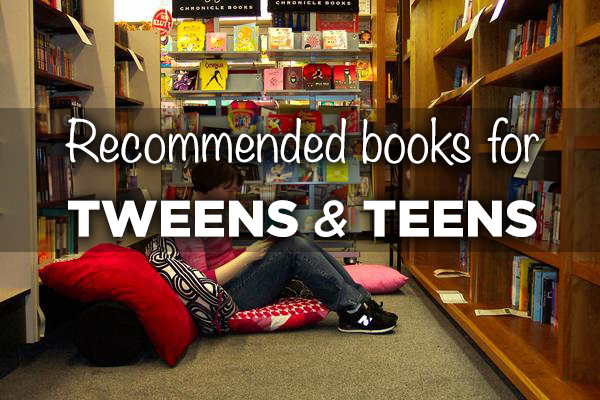
If you’re here looking for books for teens and tweens, check out our latest page (September 2013) with even more books!
The Books
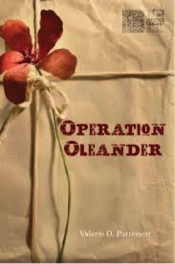
Operation Oleander
Valerie O. Patterson
Clarion
192 pp.
Ages 10 and up
Reviewed by Terry Lim Diefenbach
Army base life isn’t exactly relaxing for Jess Westmark during the summer between 8th and 9th grade. With the sometimes reluctant help of best friends, Meriwether and Sam, she keeps busy raising funds for her pet project “Operation Oleander” which sends supplies to a girls’ orphanage in Afghanistan. Jess’ dad and Meriwether’s mom are deployed to Afghanistan, a seemingly good fit for Operation Oleander because they are in place to deliver the goods and report back with inspiring photos. But when the latest delivery is interrupted by an attack on the orphanage and Meriwether’s mom is killed, Jess has to rethink her intentions. Just about everyone, including Meriwether, blames the attack on the Oleander delivery. Sam’s dad, the base commander, asks her to put her fundraising on hold. Weighted down with feelings of guilt, Jess must decide if she has to give up Operation Oleander. For Jess, the name Oleander had symbolized a bond between Afghanistan and the U.S. The beautiful plant grows in both countries. Forced to acknowledge its dark side, she also knows its strength: it is poisonous but thrives in poor soil.
Though for most of us, the Afghan war is reduced to news items, Patterson reminds us that for the families of military personnel serving there, it is a constant and evolving commitment. In Jess she has found a spirit of that community determined to do good in spite of unexpected obstacles. Jess will find a way to continue her cause.
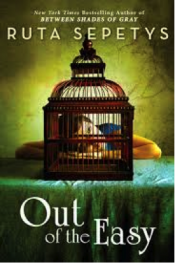
Out of the Easy
Ruta Sepetys
Philomel
346 pp.
Ages 12 and up
Reviewed by Erin Teagan
It’s 1950 and 17-year-old Josie Moraine lives in the back of a bookshop in the French Quarter of New Orleans. Her life hasn’t been the easiest. Her mother is a prostitute and a thief and Josie survives by splitting her time between selling books and cleaning the brothel. She wants more though, an education and a new start where nobody knows her as the prostitute’s kid. Unfortunately, a well-to-do tourist visits the book shop and later, turns up dead in the French Quarter. Josie knows it’s not a heart attack and her suspicions are confirmed when she finds his expensive watch in her mother’s bedroom at the brothel. Then, a dangerous man from her past shows up. It’s a time of decisions for Josie. Can she get out of New Orleans and fulfill her dream of going to Smith College before her mother’s past and present troubles suck her back in?
Author Ruta Sepetys does a fabulous job bringing the underworld of the French Quarter to life with gritty and endearing characters that stay with you after the book ends. The setting is amazing and realistic. Readers who enjoyed Judy Blundell’s What I Saw and How I Lied will also like this novel, so dark and rich with mystery. Fans of Sepetys’ first novel, Between Shades of Gray, will be far from disappointed by her second.
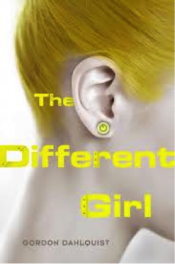
The Different Girl
Gordon Dahlquist
Dutton Juvenile
230 pp.
Ages 12 and up
Reviewed by Mary McCusker Goodie
Playwright and novelist Gordon Dahlquist’s first work of young adult science fiction, The Different Girl, is an intriguing tale that captivates the reader from the start. The story’s unique narrator, Veronika, lives on an isolated island along with her three sisters. She attends classes, does chores, and strives to please her two adult caretakers by being a good student and adhering to their strict rules. When a girl named May washes ashore on the island, life becomes less predictable. May’s arrival causes worry and tensions grow between the girls’ caretakers. Fascinated with May, Veronika struggles to place the girl within the parameters of her own experiences and vocabulary. As Veronika and her sisters try to make sense of May and the newcomer’s emotional reactions, the reader fills in the story’s gaps that Veronika herself struggles to comprehend and explain. Dahlquist’s ability to draw the reader into Veronika’s world by entwining the familiar with the futuristic keeps the story both fresh and fascinating. Veronika’s naivety and her strong desire to make sense of the world make her an endearing and memorable character. Women of all ages may find it easy to identify with Veronika, but the mystery surrounding May’s arrival and the ensuing action may also appeal to many male readers. The Different Girl is a science fiction novel with heart. Dahlquist’s work highlights the mysterious ability to learn, the beauty of intuition, and challenges the very definition of what it means to be human.
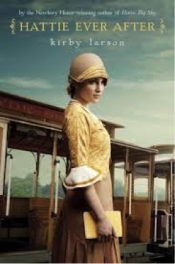
Hattie Ever After
Kirby Larson
Delacorte
230 pp.
Ages 12 and up
Reviewed by Corinne Wetzel
“The more I read, the more I realize our foremothers kicked butt, and it’s a crying shame that too few of their stories are out there,” writes author Kirby Larson in the end notes for Hattie Ever After, her sparkling sequel to Newbery Honor winner Hattie Big Sky.
Hattie Brooks doesn’t linger long in post-World War I Montana after the action of the first novel ends. Despite the temptation to play it safe in Seattle with old friend Perilee and childhood beau Charlie, 17-year-old Hattie follows her dreams to San Francisco, where she aims to break into journalism in the tradition of crusading reporter Nellie Bly. Hot on the trail of the next big scoop, Hattie encounters real historical figures such as vaudeville maven Vera Clare, opera star Luisa Tetrazzini, and even Woodrow Wilson as he seeks popular support for the League of Nations. Larson masterfully weaves historical fact into a fast-moving teen-friendly plot which includes a family mystery, two handsome suitors, and unforeseen betrayal. Hattie’s gumption and can-do attitude will appeal to 21st-century girls, who will root for their plucky heroine to realize her dreams. Hattie’s occasional naiveté and trepidation at pushing herself forward in a man’s world illustrate the mindset and courage of our foremothers who strived to work outside the home. This sequel can be read as a stand-alone book, though it would be a shame to miss the experience of reading both of Larson’s meticulously researched and exquisitely crafted historical novels.
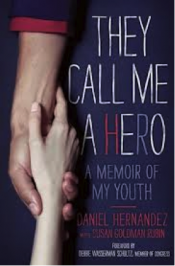
They Call Me a Hero: A Memoir of My Youth
Daniel Hernandez with Susan Goldman Rubin
Simon & Schuster Books for Young Readers
224 pp.
Ages 12 and up
Reviewed by Lisa E. Smilan
On January 8, 2011, Daniel Hernandez fearlessly rushed — amid gunshots — to aid Congresswoman Gabrielle Giffords when she was shot at a “Congress on Your Corner” gathering in Tucson, Arizona. Hernandez, a 20-year-old intern, acted quickly and helped to save Gifford’s life. While the memoir begins with his riveting account of this hellish day, Hernandez also shares his experience of growing up poor in a rough section of Tucson, and how he persevered and triumphed over obstacles to academic success. Hernandez always had an agenda different from that of a typical child or teen. He was immune to others’ attempts to bully him for being overweight, unafraid to claim his gay identity, proud of his Latino heritage. Daniel Hernandez has been hailed a hero by many, but he feels uncomfortable with the label. His definition of “hero” is “someone who has given of themselves in the service of others, like teachers, doctors, judges, and presidents.” Yet, already he has served on a local commission on LGBT issues and is an elected member of his local school board. Daniel wants to fight for what is right, for himself and others like him. He aspires to lead a life where he can be an agent of change for the better. Only then, will he think himself a hero. Most people would agree he’s already there. This nonfiction book will fascinate young adults interested in careers in public service, and will be particularly inspirational to both LGBT and Latino youth.
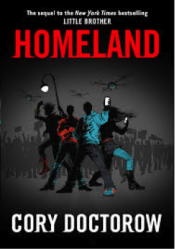
Homeland
Cory Doctorow
Tor Teen
400 pp.
Ages 13 and up
Reviewed by Beth Bayley
Homeland begins at the Burning Man Festival, where hacker and activist Marcus Yallow is entrusted with a drive full of volatile information, which he has to disseminate in order to expose crimes committed by the government. Marcus’ hometown, San Francisco, is a world of random searches, privacy invasion, and unchecked government power following a terrorist attack on the Bay Bridge. Now Marcus has to dodge the authorities and get the information out — before the Department of Homeland Security finds out. Homeland deals with issues that are personal as well as global. Marcus starts working for an independent candidate for Senate, while worrying about his out-of-work parents and trying to deal with the celebrity that came from leading a hacker army. Marcus’ relationship with his girlfriend, Ange, isn’t rosy, either, and his post-traumatic stress isn’t helping. This may sound bleak, but Marcus’ story is exciting and ultimately hopeful, and he uses technology to rally others to help make positive change. Homeland is the second book in a series. Doctorow, a tech writer, has made the first book, Little Brother, available online for free. Prior events are summarized, but readers would probably like Homeland better after reading Little Brother. Marcus is a kid who knows his stuff, and Homeland contains empowering and informative sections on everything from cold-brewing coffee to calculating random numbers to how to beat a lie detector. Marcus is also relatable, self-doubting and stressed about the moral quandaries he faces. Homeland invites a dialogue about technology and the future — and it’s a book about why people matter in a world of systems. There are some very serious themes (Marcus was waterboarded in Little Brother) but older, tech-savvy teens will absorb the readable discussions of math, privacy, and activism.
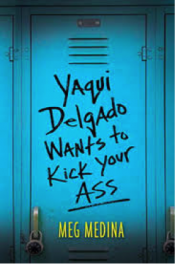
Yaqui Delgado Wants to Kick Your Ass
Meg Medina
Candlewick
272 pp.
Ages 14 and up
Reviewed by Sarah McGuire
In Meg Medina’s Yaqui Delgado Wants to Kick Your Ass, Piddy Sanchez enrolls at a new high school and instantly becomes a bully’s new target. Yaqui is out to get her, and Piddy doesn’t have a clue why. At first, Piddy thinks if she can just avoid Yaqui and concentrate on her classes, everything will be fine. Yet the bullying grows increasingly ugly. Piddy’s attempts to escape it affect every facet of her life: her grades, her relationship with her mother, and her deepening desire to learn about the father she never knew. In the end, Piddy must decide how to face her tormentor without running away or losing herself in the process. As a high school teacher, Piddy’s story rang true. It absolutely nails the isolating effects of bullying and how it can happen to good kids in normal schools. Yaqui Delgado Wants to Kick Your Ass doesn’t gloss over Piddy’s experiences, but it possesses a warmth and wisdom that allows the reader to navigate them. I highly (highly, highly!) recommend this young adult novel.
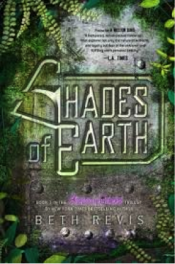
Shades of Earth
Beth Revis
Razorbill
364 pp.
Ages 14 and up
Reviewed by Jess Stork
Beth Revis doesn’t disappoint fans in this conclusion of the Across The Universe trilogy. A young adult science fiction thriller, Revis’ tale is somewhat reminiscent of Romeo and Juliet, a pair of star crossed lovers in space. She opens with an action-packed scene that sets the pace. Amy and Elder find themselves on the shuttle of Godspeed with their fingers hovering over the launch button. The ship has become divided and a large portion of Elder’s people are staying behind while they launch to the planet below. It’s a one way trip. They’ve determined that the atmosphere is suitable for human life, and despite warnings of a potential “monster” population, Amy has decided that living without walls is worth it. Immediately, it’s clear that the dangers of this new frontier may kill them. Amy’s father and the other cryogenically frozen shipmates consider Elder’s people second class citizens. The “monster” population seems to be picking them off one by one, and it’s clear that a sentient alien population is trying to destroy them. Amy’s father and Elder will need to coexist as leaders if the colonists are to survive. Readers who haven’t encountered the other books in the trilogy might find themselves confused with the myriad of characters and back story that has been established over the other two books. However, once past the opening chapters, new readers will find themselves immersed in a fast-paced plot that gathers speed until the action-packed and satisfying ending. Science fiction is somewhat rare in young adult literature, and this book sets a high standard for those that come behind it. Readers who have anxiously anticipated the end of Amy and Elder’s story will find the answer to the long awaited question: Slaves or Soldiers?
The Reviewers
Beth Bayley is a librarian, archivist, and writer in Washington, D.C.
Terry Lim Diefenbach, a writer and illustrator, lives in California and is currently illustrating hand shadow puppets.
Jess Stork works in a Children’s Room for the DC Public Library where she concocts crazy programs such as the Poetry Carnival and the Haiku Egg Hunt. At night, she stamps out middle grade stories.
Mary McCusker Goodie is a writer, editor and teacher. She lives in Montgomery County, Md. with her husband and three sons.
Sarah McGuire works as a high school teacher in central Va. and is currently writing a young adult novel. She and a group of fellow writers and illustrators blog about the kidlit jungle in Turbo Monkey Tales: http://turbomonkeytales.blogspot.com/
Lisa Smilan writes novels for adults and young adults and is an associate editor for The Washington Independent Review of Books. She is an attorney and lives in Montgomery County, Md.
Erin Teagan is currently taking a break from her science career to be at home with her two children. She reads many children’s books and is a reviewer for Children’s Literature Database.
Corinne Wetzel teaches English to 120 awesome 7th graders in Chantilly, Va. She is an avid reader of young adult fiction.

